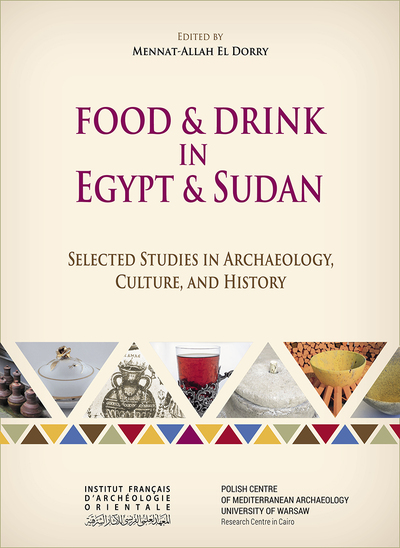- EAN13
- 9782724709544
- Éditeur
- IFAO
- Date de publication
- 1 février 2024
- Collection
- BIBLIOTHEQUE DE
- Nombre de pages
- 328
- Dimensions
- 28,3 x 20,5 x 3 cm
- Poids
- 1196 g
- Langue
- eng
Food And Drink In Egypt And Sudan, Selected Studies In Archaeology, Culture, And History
El Dorry M-A.
IFAO
Prix public : 43,00 €
Un panorama complet de l’alimentation en Égypte et au Soudan du IVe millénaire av. J.-C. jusqu’à nos jours. L’étude des modes alimentaires historiques est aussi multiple et variée que la nourriture elle-même. Les changements que nous observons dans les habitudes et les choix alimentaires au fil du temps révèlent l’évolution des climats sociaux et politiques et nous aident à imaginer la vie quotidienne et l’au-delà de nos ancêtres. La nourriture jouait certainement un rôle dans les rites funéraires ; elle était offerte aux défunts, bien sûr, mais aussi partagée dans ou à proximité de la sépulture entre les membres vivants de la famille, jetant symboliquement un pont entre le monde d’ici-bas et l’au-delà. Le choix des aliments s’inscrivait dans une série de traditions et de normes ; la comparaison de ceux offerts avec ceux ordinairement consommés permet de comprendre la signification qui leur était attribuée. Les fêtes, qu’elles soient destinées aux morts ou aux vivants, étaient chargées d’une signification politique et sociale. Le jeûne, bien que consistant à s’abstenir de certains aliments, implique également la gestion – depuis l’approvisionnement et le stockage jusqu’à la cuisson et la consommation – des aliments autorisés, une préoccupation essentielle dans des contextes tels que les monastères, où le jeûne était pratiqué. Cet ouvrage collectif rend compte de la diversité des approches possibles portant sur l’alimentation. Il présente l’état actuel de la recherche sur les habitudes alimentaires de l’Égypte et du Soudan et souligne l’importance d’une collaboration interdisciplinaire plus poussée pour une approche globale. Il rassemble 16 articles couvrant l’archéologie (au sens large), la théorie, l’anthropologie, la langue, l’ethnographie et l’architecture, qui illustrent les traditions alimentaires et l’histoire de l’Égypte et du Soudan depuis le IVe millénaire av. J.-C. jusqu’au xxe siècle. -- The study of historic foodways is as multifaceted and varied as food itself. The changes we see in food habits and choices over history reveal evolving social and political climates and help us envision our ancestors’ everyday lives and imagined afterlives. Food certainly played a role in funerary rites; it was offered to the dead, of course, but also shared at the grave among the living family members, symbolically bridging between this world and the next. Choosing the food was embedded in a series of traditions and norms; how it relates to what was actually eaten in associated settlements enables an understanding of its meaning. Feasts, whether for the dead or the living, were laden with political and social meaning. Fasting, although requiring abstention from certain foods, also involves the management—from sourcing and storing to cooking and eating—of the permitted foods, a key concern in contexts such as monasteries where fasting occurred. This collective work demonstrates the diversity of possible approaches to food. It presents the current state of research on the foodways of Egypt and Sudan and highlights the importance of further interdisciplinary collaboration for a “big picture” approach. It brings together 16 articles covering archaeology (in the broadest sense), theory, anthropology, language, ethnography, and architecture to illustrate food traditions and history in Egypt and Sudan from as early as the 4th millennium BC to the 20th century.


















